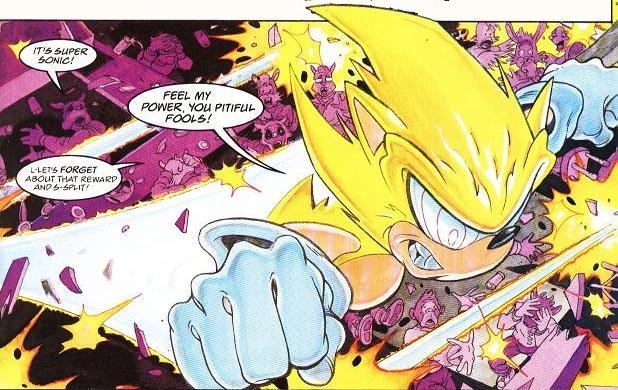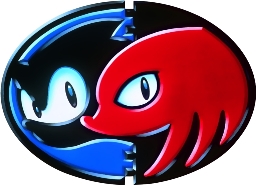Sonic Adventures (Act 4)
 |
As mentioned in the previous instalment, a second US TV series followed DiC’s first attempt. Although titled ‘Sonic The Hedgehog’, it’s usually referred to as SatAM due to the Saturday morning slot for which it was conceived. It’s a completely different proposition to its predecessor, with a complete shift of tone. I hesitate to use the word ‘serious’ for a TV show about a cartoon talking animal, but SatAM was primarily an adventure series, compared to AoStH’s pure comedy. Sonic is here shown as a member of a group of resistance fighters against Robotnik’s control of Mobius, hiding out in a forest camp near the scientist’s city stronghold. It all sounds well and good, but there’s a complete disconnection with both the ethos and detail of the games which soon grates. Unlike the carefree character we know today, this Sonic is weighted down with responsibilities, and most of his ‘missions’ see him sent to the grimy city of Robotropolis, a world away from the fascinating environments on the Mega Drive. There’s a general lack of consideration throughout- while I’m personally flattered that they give Robotnik’s first name as being ‘Julian’, it doesn’t bode well when even a cursory reading of one of the games’ manuals would have caused the creators to correct their error. This Sonic is physically weaker than in any other incarnation of the character, with his spin attack largely useless against the badniks on display here. The guerrillas are lead by one ‘Princess Sally’, behaving largely like one of the nightmarish aunts which PG Wodehouse used to menace his leading men, further removing fun from the proceedings. The other original additions to the cast aren’t much better, including a stereotypically cowardly Frenchman and one of the weaker assistants that Robotnik has been lumbered with over the years. SatAM ran for two complete series, but the concepts have continued to this day thanks to Archie Comics, who snapped up the licence to produce a US comic book. A monthly title based on a childrens’ character may sound odd to English ears, but the title has been highly successful, recently celebrating its two hundredth issue. The quality has improved over the years, with more and more characters from the games drafted in to mitigate the earlier conceptual errors. The book has usually been able to support a second title, firstly a quarterly special, before being replaced with, in turn, a Knuckles book, a spin off from the Sonic X cartoon and, most recently, a ‘Sonic Universe’ title based on secondary characters from the games.
Across the water, the European Sonic-verse was still going all guns blazing, with the arrival of Fleetway’s Sonic The Comic. STC was a fortnightly anthology book, published from 1993 to 2002, which would eventually comprise 183 issues of original content. The title was closely modelled on 2000A.D., with which it shared an editor. Each issue was built around a seven-page Sonic strip, supported by three or so other stories based on Sonic’s supporting cast or other Sega franchises. Although striving to be consistent with the other UK holders of the Sonic licence, Fleetway had authority to portray the character as they saw fit, giving their creatives a surprisingly large amount of freedom. Although a number of writers contributed to the title, Nigel Kitching and Lew Stringer were the book’s mainstays. Their differing approaches complimented each other well, with Stringer’s self-contained episodic tales punctuating Kitching’s more in-depth epics. The artistic side was more varied, but Richard Elson’s clean and energetic style deservedly secured him priority for the lead strip, which he drew for most of the book’s life. After the book had reached the five-year lifespan that Fleetway’s management had always envisaged for it, they began winding the title down, replacing back-up strips with reprints and eventually axing new content altogether. For dead licensed comic, however, it’s enjoyed a surprisingly active afterlife, and most of its creators still work in the industry today- bizarrely, some of the early stories were scripted by Mark Millar, better known these days as the creator of the Wanted franchise and Marvel’s The Ultimates. The one exception to this, however, is Kitching. The book’s lead writer sadly never found another home for his scripting talents, and these days works mainly as an illustrator in the children’s book market.
 |
Given that Sega’s core business model remained focussed on the arcades for much of the nineties, it’s surprising that the firm’s mascot should have waited until 1993 before making an appearance in that setting. Following on from an early experiment that was basically Sonic 1 with harsh time limits on the levels, SegaSonic The Hedgehog was a rather curious venture, developed in the company’s native land. The game was controlled with trackballs, which served to guide the player characters through linear levels in a bid to escape from Robotnik’s fortress. The big gimmick was a simultaneous three-player mode, with users controlling Sonic, Ray The Flying Squirrel (!?!?) or Mighty The Armadillo, who was dusted off from a character design abandoned during development of Sonic 1. The game’s rock-hard learning curve limited its success, and plans to localise it for the west using designs from the second TV series fell by the wayside. Despite the lack of official distribution in outside Japan, a few cabinets made it over- I can distinctly remember being disappointed by it during a visit to Segaworld in London.
Sticking with spin-offs, it’s well worth taking a moment to mention Dr Robotnik’s Mean Bean Machine, if only because it’s easily the highest quality effort of the games which had the Sonic branding slapped on them at the last minute. A western release of Japanese puzzle title Puyo Pop (a series later adopted by Sonic Team), it was tweaked by Sega America to feature the cartoon series versions of Robotnik and his robot minions. At this point, Sonic merchandise was selling strongly, with several companies making a good return on their licensing deals, and the character’s owner obviously wanted some of the action. Sega’s obscure Pico machine, aimed at younger children, saw two titles featuring the Sonic gang during its fittingly short life, in the form of 1994’s Tails and the Music Maker and the mini-game collection Sonic Gameworld. There is nothing of any interest that can be written about either of them.
 |
The final 16-bit instalment of the core series arrived late in 1994, with the release of Sonic & Knuckles. The echidna’s popularity had caused a redesign of the second half of Sonic 3, promoting him to fully playable status in a second campaign set after the conclusion of Sonic’s story. Using a custom-designed ‘lock-on’ cartridge, the game could be played in a number of configurations. Just placing the mushroom the Mega Drive’s slot presents a prospect similar to the first title, with the exception of the choice of playing as Sonic or Knuckles before commencing the game. Players then proceed to work their way through their chosen avatar’s levels, in the usual fashion. The design of the cartridge, however, allows other games to be plugged into the top, and connecting it to Sonic 3 creates the full version of that game, with Sonic having to battle his way through fourteen of the larger zones in order to finally destroy the Death Egg. Knuckles is also now fully playable, and his story shows him battling to finally expunge Robotnik’s leftover badniks from his island. What proved absolutely fascinating for fans were his different abilities, with a lower jump offset by his capacity to climb walls and glide across chasms, offering up a very different mode of progression through each of the existing Sonic 3 levels. Some acts are almost entirely different when played as the echidna, and he offered a rewardingly different journey around the environments.
 |
The lock-on cartridge, however, offered a greater sales gimmick then the original plans for it would have produced. Although the graphical style of each of the Mega Drive titles differs drastically, in coding terms they were actually been built on top of each other, with chunks of engine re-used each time. This made it a relatively simple task to insert Knuckles’ sprite and handling code into Sonic 2, and there was enough space in the S&K cartridge to throw in a few bonus areas that could only be accessed using the Echidna’s abilities. In plot terms this was nonsensical, of course, but made for a nice extra to temper the fact that building the full game of Sonic 3 would effectively set the player back ninety quid. Contrary to popular belief, there was also little trouble in getting Knuckles to be playable in the original Sonic game, with the vetoing factor being pallet problems rather than gameplay. Sorting out the colour difficulties that resulted from the inclusion of such later code would have consumed a disproportionate amount of time, and so the planned (and vaguely obscene-sounding) ‘Knuckles The Echidna in Sonic The Hedgehog’ was junked in favour of the famed ‘Get Blue Spheres’ game which gave players access to a near-infinite number of levels for the Sonic 3 special stage.
Turning back to the core title itself, S&K offered effectively five new full-sized levels for Sonic 3, plus an array of smaller stages designed to advance the story. The plot is choreographed in more detail than even before, with the heart of the island at the Hidden Palace Zone largely being devoted to conveying the story. Here, Knuckles discovers Robotnik’s true nature when he seizes the Master Emerald to fuel the Death Egg, and begins to assist Sonic in his campaign. The game delved further into the mythology of the Chaos Emeralds, suggesting that they had originally been the creation of Knuckles’ lost race of echidnas, and had served with the Master Emerald to power Angel Island. This was later retconed by Sonic Adventure, however, which showed the Master Emerald’s operation as being disrupted by the presence of its little brothers, restoring the Chaos Emeralds’ unknown origins. The longer length of the game mean that there was a risk of players having access to Super Sonic/Knuckles of the majority of its length on first playthough, so gamers were invited to gamble. Accessing a special stage after clearing the first six levels would bring them the to Hidden Palace’s emerald chamber, where they could trade in the Chaos Emeralds, depriving themselves of Super powers in the hope that clearing the next batch of social stages would power up the crystals into Super Emeralds, giving access to a new ‘Hyper’ version of their character with even greater abilities.
The Sky Sanctuary Zone features an intriguing element, with both Sonic and Knuckles facing off against an armoured Sonic-shaped badnik. There was nothing new in this, of course, with Sonic CD having introduced the beautifully designed Metal Sonic. This had been followed up with the stone-like robot guarding Sonic 2’s Death Egg Zone and the ‘Silver Sonic’ who serves as the penultimate boss of the 8-bit version of the same title, but the Kazuyuki Hoshino design for the Mega CD was seen as a unique character despite his apparent destruction in the Stardust Speedway Zone. The mystery was why Sonic Team hadn’t revived this creation for a turn to be again beaten by Sonic and then comprehensively taken apart by Knuckles. It’s possible that despite the involvement of Naoto Ohshima in the add-on title, Sonic Team didn’t quite view the game produced by a separate team as ‘canon’ and wanted to try their hand at introducing their own version of the character. If this supposition is true, then they at least threw in the towel with a good grace afterwards. As an in-joke in Sonic Adventure, both the Sonic CD and Sonic & Knuckles versions of Metal Sonic can be glimpsed side-by-side in stasis pods in Robotnik’s base. Since this point, only the more popular Sonic CD iteration has appeared in the series.
Perversely, the shorter Sonic & Knuckles attracted more favourable reviews that Sonic 3, with the novelty of the lock-on cartridge appealing to critics. And for actual quality? It’s more Sonic 3, as simple as that. When the game is combined with its predecessor, Sonic 3 & Knuckles stands as the pinnacle of 2D platforming, offering an unforgettable series of environments with varied & enormously entertaining gameplay. At this point, Sonic Team relocated to Japan, to work on a long-delayed idea of Naka’s for a next-generation title.
Next Time: Think we’re out of the 16-bit years? No chance. Come back in a week for spin offs galore, followed by the curious case of Sonic X-Treme…
About this entry
- By Julian Hazeldine
- Posted on Sunday, July 05 2009 @ 7:13 pm
- Categorised in Games, Analysis
- Tagged with sonic the hedgehog, Sonic Adventures, Sega
- 2 comments

I have nothing useful to contribute (or minute factual inaccuracies to bitch about), but I do want to say that I’m really enjoying this series of write-ups.
By Phil
July 07, 2009 @ 9:37 pm
reply / #
While this is an old topic and you have the next parts already up, I must state my opinions on the SatAM series, although I still respect yours.
Firstly, I never really concidered Soinc to be “weak” in this show, I just felt he’d been humanized (yes, I KNOW he’s a hedgehog!) and stopped being an “I can do anything” type of hero as he was in the other Sonic TV Series (The one with the more stupid Robotnic) which I did like but could never take seriously. I also realized (even as a kid) that the SatAM show had been removed from the games storyline, but I didn’t mind that (strangly - it’s usually one of the first things I moan about when rating a game-become-show) because the Sonic games that I played did very little to emphasize their storyline within the game (very few games really bothered then - even the really good ones like Sonic).
I never really saw Sally as a “nightmarish aunt” either, I always found her a likeable character, and was supportive of the S/S paring in *this* show (I found the S/A paring good in other shows - they’re different realities to me), I found the cast in SatAM to be likable, and while I notice that there is indead a “Cowardly Frenchman” in the cast, I never saw it as a stereotype because he was the first Cowardly Frenchman I ever saw on TV - infact he’s the only one I can think of, so it’s probably not a known sterotype.
Anyway that’s my opinion.
By MJNSEIFER
July 28, 2009 @ 9:27 pm
reply / #